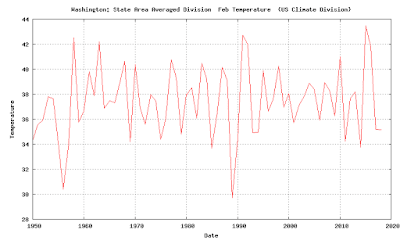It will be the third coldest February in a record going back to the late 1940s.
The average temperature this month at Sea-Tac I calculated was 36.46 F.
The coldest Februaries at Sea Tac were 35.64F in 1956 and 35.88F in 1989.
2019 is next in line, followed by 37.3F in 1949. I can't imagine this rank changing no matter what the temperature is the next two days.
This February is particularly cold considering all the construction (and thus warming) in the area around Sea-Tac Airport since 1989. So meteorologically we really we in a league with the top two.
A plot of Sea-Tac Airport temperatures, with the normal highs and lows, is, well, chilling. We had a week where the average high barely hit the average low, and in no day since Feb 4th has the our high temperature even approached the normal high. The last few days have even cooled.
An interesting question is whether there are been much of a trend in February temperatures over Puget Sound.
Using the wonderful NOAA ESRL website, here is a plot of the February mean temperatures over the Puget Sound lowlands from 1950 to 2018. A lot of variability but little trend over the past 70 years. Interestingly, there is a big cold spell in February roughly every 30 years: 1956, 1989, and 2019 (not shown, but there will be another major spike down this year).
A plot of Sea-Tac Airport temperatures, with the normal highs and lows, is, well, chilling. We had a week where the average high barely hit the average low, and in no day since Feb 4th has the our high temperature even approached the normal high. The last few days have even cooled.
An interesting question is whether there are been much of a trend in February temperatures over Puget Sound.
Using the wonderful NOAA ESRL website, here is a plot of the February mean temperatures over the Puget Sound lowlands from 1950 to 2018. A lot of variability but little trend over the past 70 years. Interestingly, there is a big cold spell in February roughly every 30 years: 1956, 1989, and 2019 (not shown, but there will be another major spike down this year).
The whole state? Pretty much the same story (see below). Little evidence of long-term warming, but several degrees of variability (up and down excursions). Later in the century, we would expect some warming due to increasing greenhouse gases, but warming is slowed here in the Northwest by the slow to warm eastern Pacific.
The expected snowfall in that period is essentially zero near the water, but ramps up towards the Cascades. Portland gets some light snow. Nothing to rush to the food store for. But more good news for the Cascade snowpack.
from Cliff Mass Weather and Climate Blog https://ift.tt/2Egw50H
























